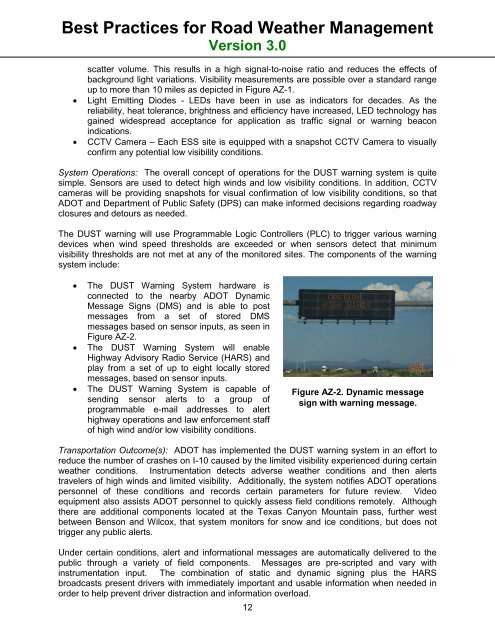Road Weather Management Program - FHWA Operations - U.S. ...
Road Weather Management Program - FHWA Operations - U.S. ...
Road Weather Management Program - FHWA Operations - U.S. ...
Create successful ePaper yourself
Turn your PDF publications into a flip-book with our unique Google optimized e-Paper software.
Best Practices for <strong>Road</strong> <strong>Weather</strong> <strong>Management</strong>Version 3.0scatter volume. This results in a high signal-to-noise ratio and reduces the effects ofbackground light variations. Visibility measurements are possible over a standard rangeup to more than 10 miles as depicted in Figure AZ-1.• Light Emitting Diodes - LEDs have been in use as indicators for decades. As thereliability, heat tolerance, brightness and efficiency have increased, LED technology hasgained widespread acceptance for application as traffic signal or warning beaconindications.• CCTV Camera – Each ESS site is equipped with a snapshot CCTV Camera to visuallyconfirm any potential low visibility conditions.System <strong>Operations</strong>: The overall concept of operations for the DUST warning system is quitesimple. Sensors are used to detect high winds and low visibility conditions. In addition, CCTVcameras will be providing snapshots for visual confirmation of low visibility conditions, so thatADOT and Department of Public Safety (DPS) can make informed decisions regarding roadwayclosures and detours as needed.The DUST warning will use <strong>Program</strong>mable Logic Controllers (PLC) to trigger various warningdevices when wind speed thresholds are exceeded or when sensors detect that minimumvisibility thresholds are not met at any of the monitored sites. The components of the warningsystem include:• The DUST Warning System hardware isconnected to the nearby ADOT DynamicMessage Signs (DMS) and is able to postmessages from a set of stored DMSmessages based on sensor inputs, as seen inFigure AZ-2.• The DUST Warning System will enableHighway Advisory Radio Service (HARS) andplay from a set of up to eight locally storedmessages, based on sensor inputs.• The DUST Warning System is capable ofsending sensor alerts to a group ofprogrammable e-mail addresses to alerthighway operations and law enforcement staffof high wind and/or low visibility conditions.Figure AZ-2. Dynamic messagesign with warning message.Transportation Outcome(s): ADOT has implemented the DUST warning system in an effort toreduce the number of crashes on I-10 caused by the limited visibility experienced during certainweather conditions. Instrumentation detects adverse weather conditions and then alertstravelers of high winds and limited visibility. Additionally, the system notifies ADOT operationspersonnel of these conditions and records certain parameters for future review. Videoequipment also assists ADOT personnel to quickly assess field conditions remotely. Althoughthere are additional components located at the Texas Canyon Mountain pass, further westbetween Benson and Wilcox, that system monitors for snow and ice conditions, but does nottrigger any public alerts.Under certain conditions, alert and informational messages are automatically delivered to thepublic through a variety of field components. Messages are pre-scripted and vary withinstrumentation input. The combination of static and dynamic signing plus the HARSbroadcasts present drivers with immediately important and usable information when needed inorder to help prevent driver distraction and information overload.12
















